Instruction
Core Training: Are We Missing Something Here?
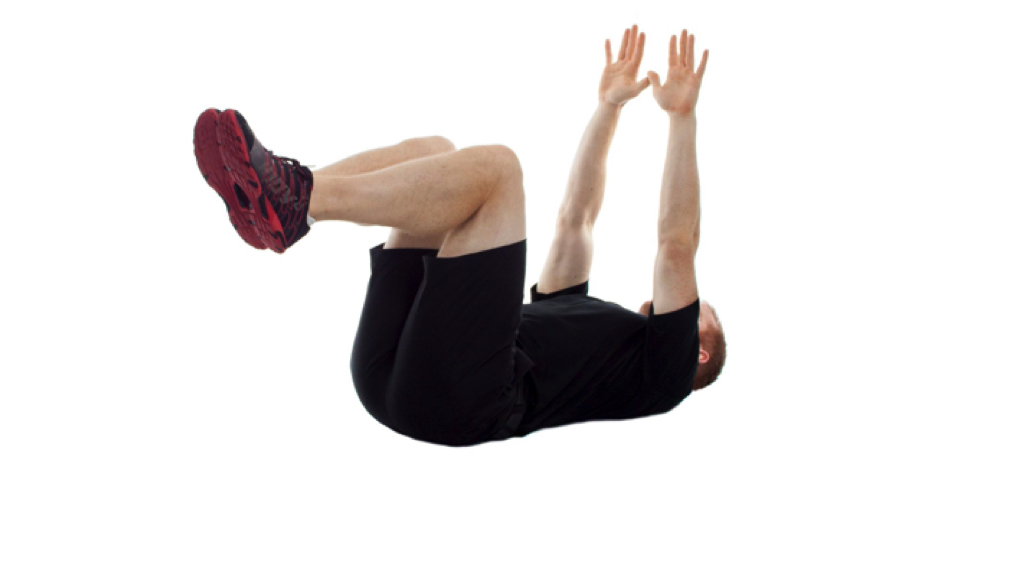
The majority of core work is performed either horizontally (prone and supine), sitting or kneeling. After speaking with some people much smarter than me, namely Mark Bull (UK based Bio Mechanist), I have been wondering whether we are missing a key opportunity to get some really important work done by not performing more core exercises in a standing position.
I mentioned in a previous GolfWRX article that I think we in the golf fitness world should resist the temptation of grabbing the low-hanging fruit of loaded rotational training before taking care of the fundamentals of quality movement and strength in the sagittal and frontal planes (front to back and side to side). So I’m not advocating throwing out the fundamental exercises that make up a solid training program, more so, I’m searching for opportunities in the supplementary exercises where we can train the core in a manner that has more effective transfer to our golf swing.
After reading an article by Mark Bull, and being very fortunate to be able to catch up in person for a chat, he got me thinking about the way I program core training especially. In the article, Bull talked about some analysis work he did on a long-drive champion that caused him to question to the X-Factor Stretch Theory of hitting the long ball.
“The interaction between the pelvis and thorax has been researched for years, and for many, it is seen as having a significant influence on driving distance,” Bull said. “However, on recently testing a world long drive champion, the values he returned started to question my own understanding and value of this interaction. For years, we have been led to believe that high levels of stretch at the start of downswing between the pelvis/thorax is required to help generate maximum club head speed. However, the long-drive champion failed to produce more than 1 degree for any shot during the test. However, what was of great interest was the levels of separation/stretch achieved across other segments. Let’s define separation/stretch as elastic recoil; the levels of elastic recoil that he produced across the lead scapula/shoulder/ribcage were staggeringly high. The amount of stretch, the speed of the stretch and the rate of recoil were huge. Therefore, perhaps the interaction between thorax and arm is of more value than pelvis/thorax?”
“Typically, long hitters exhibit a reduction in the angle between the lead arm and thorax (ribcage) in transition towards impact” Bull said.
This is a really interesting thought, and it contradicts the traditional wisdom that more X Factor Stretch equals more club head speed. In fact, Bull had previously tested another elite player who had the one of the largest X-Factor Stretches of anyone he had seen, yet one of the lowest club head speeds. Given his findings, Bull suggested that training could be adapted to include more focus on elastic recoil for the whole body, as opposed to focusing solely on the the pelvis and thorax.
As is my tendency when listening to very bright people, I took this info and sought to simplify it down to my level of understanding, then apply to a relevant practical setting (the gym). I started to experiment with a Stroops Shorty Stick and a resistance band tied to one end, in my opinion this gives you the biggest bang for your buck in terms of stability challenge. Whilst not quite as effective, you can use any kind of stretchy band or cable machines with a handle.
Stroops Shorty Stick with resistance band attached
I am going to show you a selection of the exercises that I have been using that I feel tick the boxes of quality connection to the ground, pelvic stability, spinal stability and scapula stability under rotational load to work on this “all-body elastic recoil” that Bull was talking about. Importantly, I feel that these exercises give an appropriate swing-specific stimulus, while avoiding the potential detrimental impact on sequencing/motor patterns that can occur by simply loading an imitated golf swing.
My advice is to try including these exercises at the end of your workout, after you have completed your strength work, in place of your usual core work. This will ensure you are both warmed up and not at risk of tiring out your core before doing exercises that require you to use your core to perform the movement safely (back squats, for example).
As always, gain consent from your relevant medical professional first and be careful to start with a light resistance band or cable load and work your way up gradually. Two-to-three sets of 6-8 repetitions on each side using a slow tempo is ideal to start. Work up to faster speeds and heavier loads once confident with the technique. You should feel these exercises working predominantly your glutes/hip complex, core and shoulders/arms, as well as challenging your ability to maintain solid connection with the ground. If you are feeling more strain in your lower back and less in the targeted areas stop immediately and seek out the advice of a good fitness professional.
Stick/Band Press: Neutral Stance
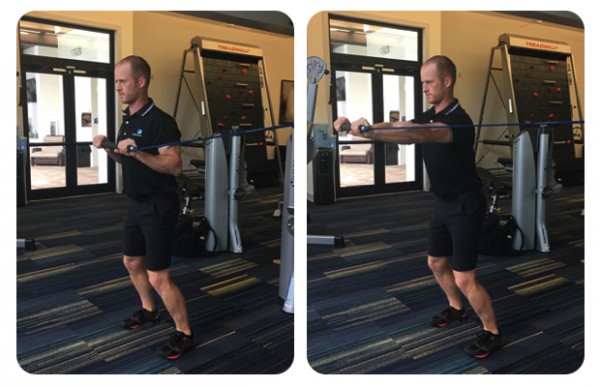
Positioning: Upright stance, core and glutes engaged.
Form: Press stick out in front of body, fight the resistance pulling you to the left. Keep scapulae (shoulder blades) and shoulders as stable as possible. Hold for 2 seconds, return to start position and repeat. Perform equal reps on both sides.
Stick/Band Pallof Press
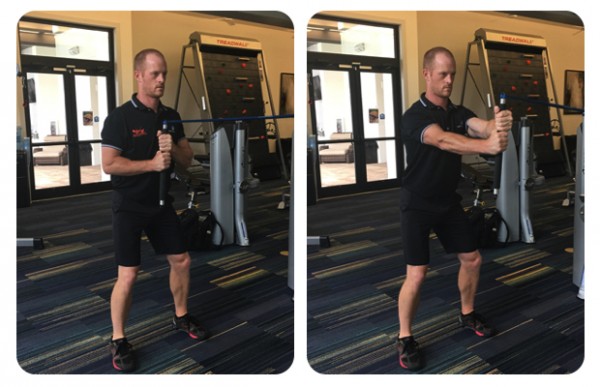
Positioning: Upright split stance, core and glutes engaged, facing at 90 degrees to band/cable anchor point.
Form: Press the stick/band out in front of the chest, fight the resistance pulling you to the left. Keep scapulae, shoulders and torso as stable as possible. Hold for 2 seconds, return to start position and repeat. Perform equal reps on both sides.
Stick/Band Turn: Split Stance
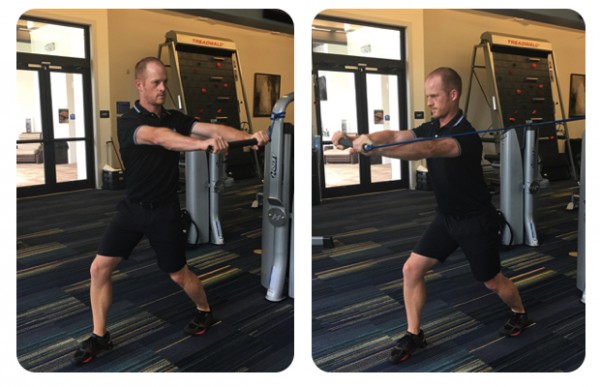
Positioning: Upright split stance, core and glutes engaged, torso rotated 90 degrees to band/cable anchor point.
Form: Rotate to right until chest and shoulders are facing forward, fight the resistance pulling you to the left. Keep scapulae and shoulders as stable as possible. Hold for 2 seconds, return to start position and repeat. Perform equal reps on both sides.
Stick/Band Turn: 90-90 Stance (less strain on back, more opportunity to turn through hips)
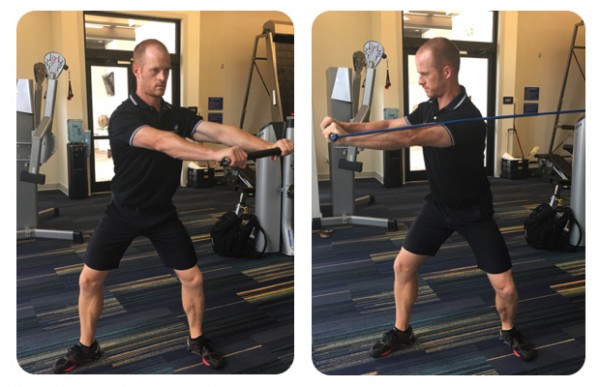
Positioning: Upright 90-90 stance (open hips, feet pointing at 90 degrees), core and glutes engaged, torso rotated 90 degrees to band/cable anchor point.
Form: Rotate to right until chest and shoulders are facing the same direction as lead foot, fight the resistance pulling you to the left. Keep scapulae and shoulders as stable as possible. Hold for 2 seconds, return to start position and repeat. Perform equal reps on both sides.
Stick / Cable Pull Across
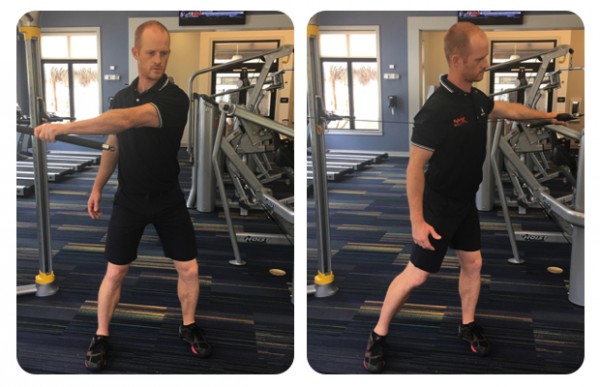
Positioning: Upright stance, side on to anchor point. Lead arm pulled across torso.
Form: Rotate torso and pull arm to the left, away from anchor point. Keep scapula as stable as possible, return to start position and repeat. Perform equal reps on both sides.
—
For more information on Mark Bull and his services click here. For more on Nick Randall and his range of golf specific training programs and equipment click here.
- LIKE79
- LEGIT2
- WOW2
- LOL1
- IDHT2
- FLOP1
- OB0
- SHANK5
Instruction
Clement: Laid-off or perfect fade? Across-the-line or perfect draw?

Some call the image on the left laid off, but if you are hitting a fade, this could be a perfect backswing for it! Same for across the line for a draw! Stop racking your brain with perceived mistakes and simply match backswing to shot shape!
- LIKE0
- LEGIT0
- WOW0
- LOL0
- IDHT0
- FLOP0
- OB0
- SHANK1
Instruction
The Wedge Guy: The easiest-to-learn golf basic

My golf learning began with this simple fact – if you don’t have a fundamentally sound hold on the golf club, it is practically impossible for your body to execute a fundamentally sound golf swing. I’m still a big believer that the golf swing is much easier to execute if you begin with the proper hold on the club.
As you might imagine, I come into contact with hundreds of golfers of all skill levels. And it is very rare to see a good player with a bad hold on the golf club. There are some exceptions, for sure, but they are very few and very far between, and they typically have beat so many balls with their poor grip that they’ve found a way to work around it.
The reality of biophysics is that the body moves only in certain ways – and the particulars of the way you hold the golf club can totally prevent a sound swing motion that allows the club to release properly through the impact zone. The wonderful thing is that anyone can learn how to put a fundamentally sound hold on the golf club, and you can practice it anywhere your hands are not otherwise engaged, like watching TV or just sitting and relaxing.
Whether you prefer an overlap, interlock or full-finger (not baseball!) grip on the club, the same fundamentals apply. Here are the major grip faults I see most often, in the order of the frequency:
Mis-aligned hands
By this I mean that the palms of the two hands are not parallel to each other. Too many golfers have a weak left hand and strong right, or vice versa. The easiest way to learn how to hold the club with your palms aligned properly is to grip a plain wooden ruler or yardstick. It forces the hands to align properly and shows you how that feels. If you grip and re-grip a yardstick several times, then grip a club, you’ll see that the learning curve is almost immediate.
The position of the grip in the upper/left hand
I also observe many golfers who have the butt of the grip too far into the heel pad of the upper hand (the left hand for right-handed players). It’s amazing how much easier it is to release the club through the ball if even 1/4-1/2″ of the butt is beyond the left heel pad. Try this yourself to see what I mean. Swing the club freely with just your left hand and notice the difference in its release from when you hold it at the end of the grip, versus gripping down even a half inch.
To help you really understand how this works, go to the range and hit shots with your five-iron gripped down a full inch to make the club the same length as your seven-iron. You will probably see an amazing shot shape difference, and likely not see as much distance loss as you would expect.
Too much lower (right) hand on the club
It seems like almost all golfers of 8-10 handicap or higher have the club too far into the palm of the lower hand, because that feels “good” if you are trying to control the path of the clubhead to the ball. But the golf swing is not an effort to hit at the ball – it is a swing of the club. The proper hold on the club has the grip underneath the pad at the base of the fingers. This will likely feel “weak” to you — like you cannot control the club like that. EXACTLY. You should not be trying to control the club with your lower/master hand.
Gripping too tightly
Nearly all golfers hold the club too tightly, which tenses up the forearms and prevents a proper release of the club through impact. In order for the club to move back and through properly, you must feel that the club is controlled by the last three fingers of the upper hand, and the middle two fingers of the lower hand. If you engage your thumbs and forefingers in “holding” the club, the result will almost always be a grip that is too tight. Try this for yourself. Hold the club in your upper hand only, and squeeze firmly with just the last three fingers, with the forefinger and thumb off the club entirely. You have good control, but your forearms are not tense. Then begin to squeeze down with your thumb and forefinger and observe the tensing of the entire forearm. This is the way we are made, so the key to preventing tenseness in the arms is to hold the club very lightly with the “pinchers” — the thumbs and forefingers.
So, those are what I believe are the four fundamentals of a good grip. Anyone can learn them in their home or office very quickly. There is no easier way to improve your ball striking consistency and add distance than giving more attention to the way you hold the golf club.
More from the Wedge Guy
- The Wedge Guy: Golf mastery begins with your wedge game
- The Wedge Guy: Why golf is 20 times harder than brain surgery
- The Wedge Guy: Musings on the golf ball rollback
- LIKE88
- LEGIT13
- WOW6
- LOL1
- IDHT0
- FLOP4
- OB1
- SHANK8
Instruction
Clement: Stop ripping off your swing with this drill!

Not the dreaded headcover under the armpit drill! As if your body is defective and can’t function by itself! Have you seen how incredible the human machine is with all the incredible feats of agility all kinds of athletes are accomplishing? You think your body is so defective (the good Lord is laughing his head off at you) that it needs a headcover tucked under the armpit so you can swing like T-Rex?
- LIKE0
- LEGIT2
- WOW2
- LOL0
- IDHT0
- FLOP0
- OB0
- SHANK2
-

 19th Hole3 weeks ago
19th Hole3 weeks agoDave Portnoy places monstrous outright bet for the 2024 Masters
-

 19th Hole6 days ago
19th Hole6 days agoJustin Thomas on the equipment choice of Scottie Scheffler that he thinks is ‘weird’
-

 19th Hole3 weeks ago
19th Hole3 weeks agoTiger Woods arrives at 2024 Masters equipped with a putter that may surprise you
-

 19th Hole6 days ago
19th Hole6 days ago‘Absolutely crazy’ – Major champ lays into Patrick Cantlay over his decision on final hole of RBC Heritage
-

 19th Hole2 weeks ago
19th Hole2 weeks agoTwo star names reportedly blanked Jon Rahm all week at the Masters
-

 19th Hole2 weeks ago
19th Hole2 weeks agoReport: LIV Golf identifies latest star name they hope to sign to breakaway tour
-

 19th Hole2 weeks ago
19th Hole2 weeks agoNeal Shipley presser ends in awkward fashion after reporter claims Tiger handed him note on 8th fairway
-

 19th Hole2 weeks ago
19th Hole2 weeks agoBrandel Chamblee has ‘no doubt’ who started the McIlroy/LIV rumor and why


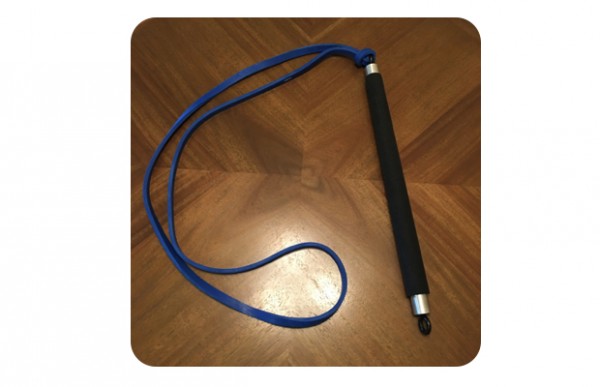















Al Czervik
Jun 1, 2016 at 12:40 pm
This is one of the best articles I have read on the subject. Thanks for taking the time to share. It would be nice to see what recommendations you would make for the strength training portion of the workout.
Nick Randall
Jun 7, 2016 at 5:35 am
Hi Al,
Sorry for the delayed response. Strength work is focused on stability first, then basic strength, then max strength, then power. Variations of squat, lunge, push and pull make up the majority of the exercise selection.
Hope this helps Al
Mark Odenthal
May 31, 2016 at 2:15 pm
Love this!
Nick Randall
Jun 7, 2016 at 5:38 am
Thanks Mark!